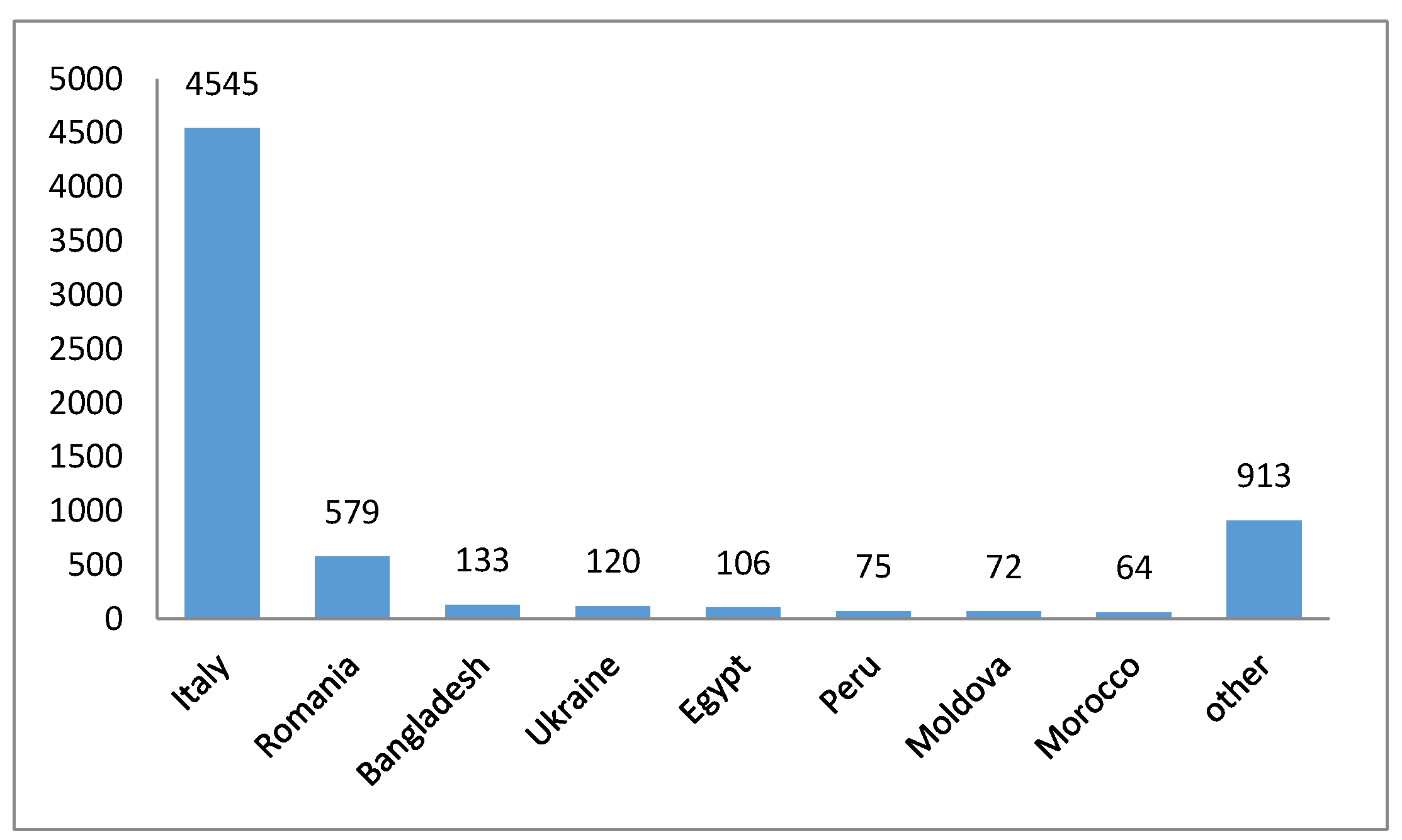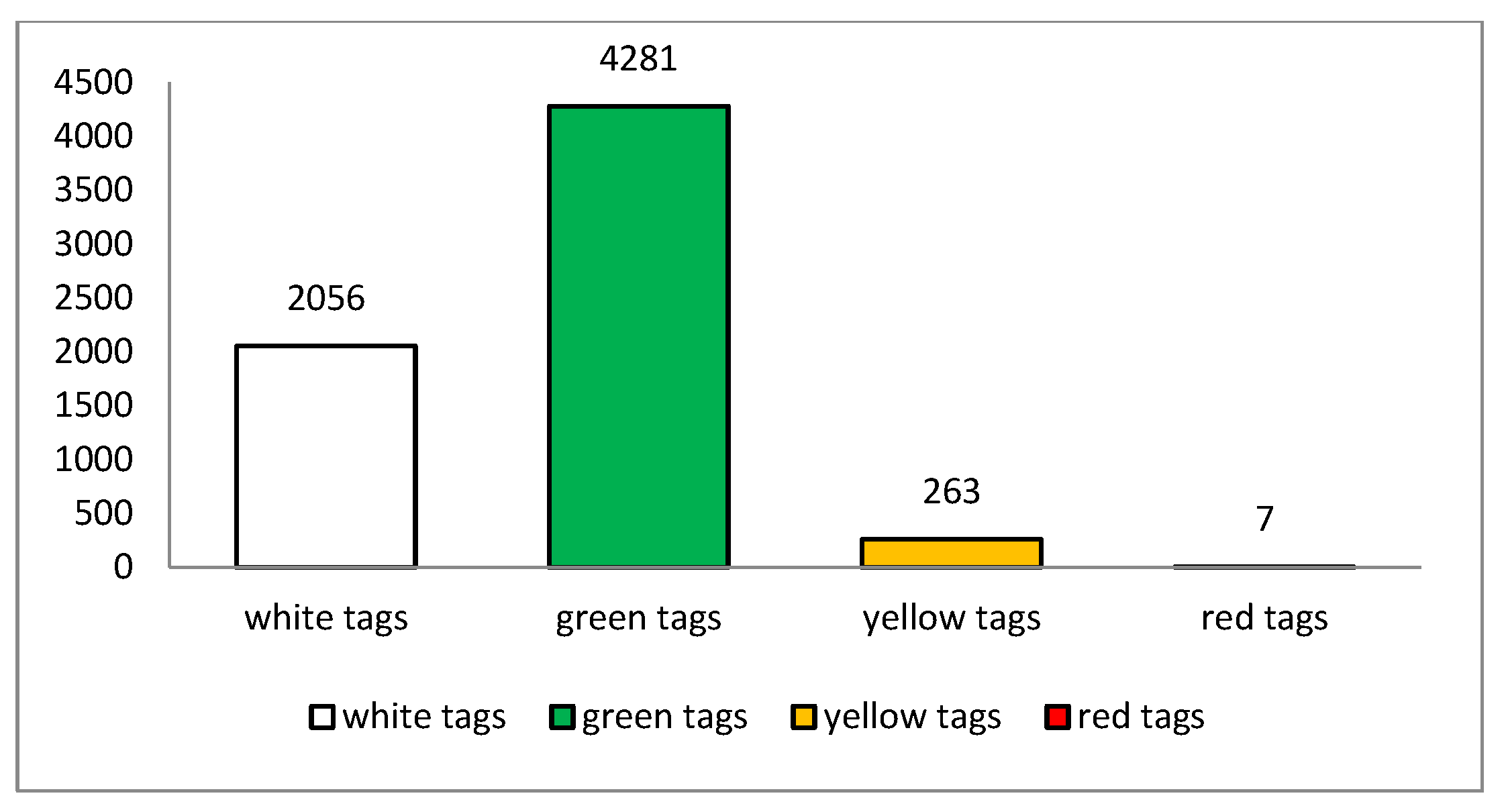Odontogenic-Related Head and Neck Infections: From Abscess to Mediastinitis: Our Experience, Limits, and Perspectives—A 5-Year Survey
Abstract
1. Introduction
2. Materials and Methods
3. Results
4. Discussion
5. Conclusions
Author Contributions
Funding
Institutional Review Board Statement
Informed Consent Statement
Data Availability Statement
Conflicts of Interest
References
- Pesis, M.; Bar-Droma, E.; Ilgiyaev, A.; Givol, N. Deep Neck Infections Are Life Threatening Infections of Dental Origin: A Presentation and Management of Selected Cases. Isr. Med. Assoc. J. 2019, 12, 806–811. [Google Scholar]
- Zheng, L.; Yang, C.; Zhang, W.; Cai, X.; Jiang, B.; Wang, B.; Pu, Y.; Jin, J.; Kim, E.; Wang, J.; et al. Comparison of multi-space infections of the head and neck in the elderly and non-elderly: Part I the descriptive data. J. Cranio Maxillo Facial Surg. 2013, 41, e208–e212. [Google Scholar] [CrossRef]
- Cachovan, G.; Phark, J.-H.; Schön, G.; Pohlenz, P.; Platzer, U. Odontogenic infections: An 8-year epidemiologic analysis in a dental emergency outpatient care unit. Acta Odontol. Scand. 2013, 71, 518–524. [Google Scholar] [CrossRef] [PubMed]
- Opitz, D.; Camerer, C.; Camerer, D.-M.; Raguse, J.-D.; Menneking, H.; Hoffmeister, B.; Adolphs, N. Incidence and management of severe odontogenic infections—A retrospective analysis from 2004 to 2011. J. Cranio Maxillo Facial Surg. 2015, 43, 285–289. [Google Scholar] [CrossRef] [PubMed]
- Bayetto, K.; Cheng, A.; Goss, A. Dental abscess: A potential cause of death and morbidity. Aust. J. Gen. Pract. 2020, 49, 563–567. [Google Scholar] [CrossRef] [PubMed]
- Anderson, W.; Ahmed, H. A retrospective analysis of hospitalisation for diseases of the pulp and periapical tissues in NHS Grampian 2011–2015: Geographic, socioeconomic and increased primary care availability effects. Br. Dent. J. 2019, 226, 951–954. [Google Scholar] [CrossRef]
- Nhongo, S.S.; Lee, K.; Chan, S.; Sklavos, A.; Tocaciu, S.; Austin, S. Redrainage in odontogenic orofacial infections: Risk factors and analysis. Oral Surg. Oral Med. Oral Pathol. Oral Radiol. 2022, 133, 28–33. [Google Scholar] [CrossRef]
- Okunseri, C.; Okunseri, E.; Xiang, Q.; Thorpe, J.M.; Szabo, A. Patient characteristics and trends in nontraumatic dental condition visits to emergency departments in the United States. Clin. Cosmet. Investig. Dent. 2012, 4, 1–7. [Google Scholar] [CrossRef]
- Shah, A.C.; Leong, K.K.; Lee, M.K.; Allareddy, V. Outcomes of Hospitalizations Attributed to Periapical Abscess from 2000 to 2008: A Longitudinal Trend Analysis. J. Endod. 2013, 39, 1104–1110. [Google Scholar] [CrossRef]
- Ottaviani, G.; Costantinides, F.; Perinetti, G.; Luzzati, R.; Contardo, L.; Visintini, E.; Tirelli, G.; Di Lenarda, R.; Gobbo, M.; Biasotto, M. Epidemiology and variables involved in dental abscess: Survey of dental emergency unit in Trieste. Oral Dis. 2014, 20, 499–504. [Google Scholar] [CrossRef]
- Jundt, J.S.; Gutta, R. Characteristics and cost impact of severe odontogenic infections. Oral Surg. Oral Med. Oral Pathol. Oral Radiol. 2012, 114, 558–566. [Google Scholar] [CrossRef] [PubMed]
- Ogle, O.E. Odontogenic infections. Dent. Clin. N. Am. 2017, 61, 235–252. [Google Scholar] [CrossRef] [PubMed]
- Hobson, D.T.G.; Imudia, A.N.; Soto, E.; Awonuga, A.O. Pregnancy Complicated by Recurrent Brain Abscess after Extraction of an Infected Tooth. Obstet. Gynecol. 2011, 118, 467–470. [Google Scholar] [CrossRef] [PubMed]
- Azenha, M.R.; Homsi, G.; Garcia, I.R., Jr. Multiple brain abscess from dental origin: Case report and literature review. Oral Maxillofac. Surg. 2012, 16, 393–397. [Google Scholar] [CrossRef]
- Tavakoli, M.; Bagheri, A.; Faraz, M.; Salehirad, S.; Roghaee, S. Orbital cellulitis as a complication of mandibular odontogenic infection. Ophthalmic Plast. Reconstr. Surg. 2013, 29, e5–e7. [Google Scholar] [CrossRef]
- Blankson, P.-K.; Parkins, G.; Boamah, M.O.; Abdulai, A.E.; Ahmed, A.-M.; Bondorin, S.; Nuamah, I. Severe odontogenic infections: A 5-year review of a major referral hospital in Ghana. Pan Afr. Med. J. 2019, 32, 71. [Google Scholar] [CrossRef]
- Nadig, K.; Taylor, N.G. Management of odontogenic infection at a district general hospital. Br. Dent. J. 2018, 224, 962–966. [Google Scholar] [CrossRef]
- Bertossi, D.; Barone, A.; Iurlaro, A.; Marconcini, S.; De Santis, D.; Finotti, M.; Procacci, P. Odontogenic Orofacial Infections. J. Craniofacial Surg. 2017, 28, 197–202. [Google Scholar] [CrossRef]
- Wang, J.; Ahani, A.; Pogrel, M.A. A five-year retrospective study of odontogenic maxillofacial infections in a large urban public hospital. Int. J. Oral Maxillofac. Surg. 2005, 34, 646–649. [Google Scholar] [CrossRef]
- Pucci, R.; Cassoni, A.; Di Carlo, D.; Della Monaca, M.; Romeo, U.; Valentini, V. Severe Odontogenic Infections during Pregnancy and Related Adverse Outcomes. Case Report and Systematic Literature Review. Trop. Med. Infect. Dis. 2021, 6, 106. [Google Scholar] [CrossRef]
- Jabłoński, S.; Brocki, M.; Kordiak, J.; Misiak, P.; Terlecki, A.; Kozakiewicz, M. Acute mediastinitis: Evaluation of clinical risk factors for death in surgically treated patients. ANZ J. Surg. 2013, 83, 657–663. [Google Scholar] [CrossRef] [PubMed]
- Thomas, S.J.; Atkinson, C.; Hughes, C.; Revington, P.; Andrew, R. Is there an epidemic of admissions for surgical treatment of dental abscesses in the UK? BMJ 2008, 336, 1219–1220. [Google Scholar] [CrossRef] [PubMed]
- Christensen, B.; Han, M.; Dillon, J.K. The cause of cost in the management of odonto-genic infections 1: A demographic survey and multivariate analysis. J. Oral Maxillofac. Surg. 2013, 71, 2058–2067. [Google Scholar] [CrossRef]
- Roy, S.; Sainuddin, S.; Clark, S. Odontogenic infections: A national survey to assess confidence of the OMFS “first on-call”. Br. J. Oral Maxillofac. Surg. 2016, 54, 1102–1105. [Google Scholar] [CrossRef] [PubMed]
- Health & Social Care Information Centre, Hospital Episodestatis-tics. Admitted Patient Care 2005–2014. Available online: http://www.hscic.gov.uk/hes (accessed on 12 June 2016).
- Katoumas, K.; Anterriotis, D.; Fyrgiola, M.; Lianou, V.; Triantafylou, D.; Dimopoulos, I. Epidemiological analysis of management of severe odontogenic infections before referral to the emergency department. J. Cranio Maxillofac. Surg. 2019, 47, 1292–1299. [Google Scholar] [CrossRef] [PubMed]
- Uluibau, I.; Jaunay, T.; Goss, A. Severe odontogenic infections. Aust. Dent. J. 2005, 50, S74–S81. [Google Scholar] [CrossRef]
- Furuholm, J.; Rautaporras, N.; Uittamo, J.; Saloniemi, M.; Snäll, J. Health status in patients hospitalised for severe odontogenic infections. Acta Odontol. Scand. 2021, 79, 436–442. [Google Scholar] [CrossRef]


| Subject Demographics | |||||
|---|---|---|---|---|---|
| Odontogenic Infection Diagnosis | Hospitalized Patients | p-Value | Patients Surgically Treated | p-Value | |
| Sample size, n (%) | |||||
| 6607 (10.38%) | 151 (2.28%) | 116 (76.82%) | |||
| Gender, n (%) | |||||
| Men Women | 3597 (54.4%) 3010 (45.6%) | 96 (63.57%) 55 (36.42%) | 0.0254 | 73 (63%) 43 (37%) | 0.0736 |
| Age (yr) mean, SD 1 | |||||
| 40.6 ± 15.5 | 39.9 ± 15.8 | 0.58 * | 37.4 ± 16.8 | 0.02 * | |
| Hospitalized Patients | Patients Surgically Treated | |
|---|---|---|
| Sample size, n (%) | 151 | 116 |
| Diagnosis | ||
| Submandibular abscess DNI 1 Ludwig’s angina Mediastinitis | 81 (53.7%) 40 (26.5%) 25 (16.5%) 5 (3.3%) | |
| Surgical treatment | ||
| Dental extraction Extraoral drainage Cervicotomy Mediastinum drainage | 103 (89%) 96 (83%) 15 (13%) 5 (4.3%) |
Disclaimer/Publisher’s Note: The statements, opinions and data contained in all publications are solely those of the individual author(s) and contributor(s) and not of MDPI and/or the editor(s). MDPI and/or the editor(s) disclaim responsibility for any injury to people or property resulting from any ideas, methods, instructions or products referred to in the content. |
© 2023 by the authors. Licensee MDPI, Basel, Switzerland. This article is an open access article distributed under the terms and conditions of the Creative Commons Attribution (CC BY) license (https://creativecommons.org/licenses/by/4.0/).
Share and Cite
Pucci, R.; Cassoni, A.; Di Carlo, D.; Bartolucci, P.; Della Monaca, M.; Barbera, G.; Di Cosola, M.; Polimeni, A.; Valentini, V. Odontogenic-Related Head and Neck Infections: From Abscess to Mediastinitis: Our Experience, Limits, and Perspectives—A 5-Year Survey. Int. J. Environ. Res. Public Health 2023, 20, 3469. https://doi.org/10.3390/ijerph20043469
Pucci R, Cassoni A, Di Carlo D, Bartolucci P, Della Monaca M, Barbera G, Di Cosola M, Polimeni A, Valentini V. Odontogenic-Related Head and Neck Infections: From Abscess to Mediastinitis: Our Experience, Limits, and Perspectives—A 5-Year Survey. International Journal of Environmental Research and Public Health. 2023; 20(4):3469. https://doi.org/10.3390/ijerph20043469
Chicago/Turabian StylePucci, Resi, Andrea Cassoni, Daniele Di Carlo, Piero Bartolucci, Marco Della Monaca, Giorgio Barbera, Michele Di Cosola, Antonella Polimeni, and Valentino Valentini. 2023. "Odontogenic-Related Head and Neck Infections: From Abscess to Mediastinitis: Our Experience, Limits, and Perspectives—A 5-Year Survey" International Journal of Environmental Research and Public Health 20, no. 4: 3469. https://doi.org/10.3390/ijerph20043469
APA StylePucci, R., Cassoni, A., Di Carlo, D., Bartolucci, P., Della Monaca, M., Barbera, G., Di Cosola, M., Polimeni, A., & Valentini, V. (2023). Odontogenic-Related Head and Neck Infections: From Abscess to Mediastinitis: Our Experience, Limits, and Perspectives—A 5-Year Survey. International Journal of Environmental Research and Public Health, 20(4), 3469. https://doi.org/10.3390/ijerph20043469









